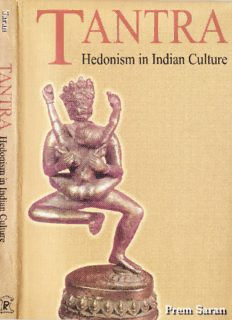
Tantra: hedonism in Indian culture PDF
Preview Tantra: hedonism in Indian culture
TANTRA Hedonism in Indian Culture Tantra in Contemporary Researches 1. Impact of Tantra on Religion and Art; by T.N. Mishra (ISBN 81-246-0073-2) 2. Lalita-Sahasranama — A Comprehensive Study of One Thousand Names of Lalita Maha-tripurasundarl; by M.L. Joshi (ISBN 81-246-0104-6) 3. Yoga-Tantra and Sensuousness in Art; by T.N. Mishra (ISBN 81-246-0239-5) 4. Tantric Hedonism of MahanadI Valley (Uddiyana Pltha); by Jitamitra Prasad Singh Deo (ISBN 81-246-0269-7) TANTRA Hedonism in Indian Culture Prem Saran D.K.Prmtworld (P) Ltd. New Delhi Cataloging in Publication Data — DK [Courtesy: D.K. Agencies (P) Ltd. <[email protected]>] Saran, Prem, 1952- Tantra: hedonism in Indian culture. Includes bibliographical references (p. ). Includes Index. ISBN 812460097X 1. Tantrism. 2. Hedonism — Religious aspects — Hinduism. I. Title. ISBN 81-246-0097-X First Published in India in 1994 Second impression in 1998 Third impression in 1999 Fourth impression in 2006 © Author All rights reserved. No part of this publication may be reproduced or transmitted, except brief quotations, in any form or by an means, electronic or mechanical, including photocopying recording, or any information storage or retrieval system, withou prior written permission of the copyright holder, indicated above, and the publishers. Published and printed by: D.K. Printworld (P) Ltd. Regd. office : 'Sri Kunj', F-52, Bali Nagar New Delhi - 110 015 Phones : (Oil) 2545-3975; 2546-6019; Fax : (Oil) 2546-5926 E-mail: [email protected] Web: www.dkprintworld.com Cover Photo: Tantric yab-yum icon in the possession of the author. To My Iccha-guru and mentor, the late Swami Agehananda Bharati Foreword In the West, pleasure or bliss, like dessert, should be taken last, after the substance of the main meal, and then in small quantities. Too much dessert, like too much pleasure, is deemed bad for a person. The health and the spirit can be weakened by these things. Pleasure, especially too much of it, is to be feared and avoided, lest a person give in to it and so succumb to moral corruption and physical decay. It is through austerity that a person achieves worthwhile ends, not through pleasure. Ecstasy is taken as evidence of madness. In India, sweets are often eaten before the meal, and in Tantric thinking and practice, pleasure or bliss- is affirmed, not repressed. It is the acknowledged central force of being. Ecstasy is desired, the mystical goal. Tantric traditions, therefore, affirm the pleasurable as natural, particularly hedonistic sexual pleasure, which is an expression of shakti, the universal force of creation, and they use its power to achieve ecstasy or bliss. Small wonder, then, that tantrism has inspired discomfort, if not outright fear, misunderstanding, and avoidance in those who have seen it as the antithesis of what they believe desirable. And so, too, readers should not be surprised that few scholars trained in Western traditions have had much to say about tantrism that is positive or insightful. They are made too uncomfortable by it. Until recently, scholars have instead found greater affinity with orthodox Vedic Hinduism, which advocates a more comfortable, familiar asceticism, as the mechanism for achieving salvation. It is this Vedic asceticism, Mr. Saran argues, influenced by British Victorianism, that has been the dominant source of orthodoxy in elite Indian urban society in recent centuries. But this orthodoxy has done little to limit the pervasiveness of tantric ideas in viii Tantra : Hedonism in Indian Culture popular Indian folk culture nor to enlighten those interested in tantric perceptions. Yet these perceptions lie at the core of Hindu thinking about being and clearly have a central place in notions of the female principle, shakti, and worship of female deities. They also lie at the core of orthodox understanding5 of God, viz. the Hindu Tantrics’ dictum: “Shivah shaktivihinah shavah", “Shiva without shakti is a corpse” (p. 34). In this short book, Prem Saran, himself a tantric initiate, offers a concise and sympathetic introduction to tantrism, its place in Bengali and Assamese culture, and to a lesser extent, its place as a pervasive non- Vedic system of thought and ritual in Hinduism. But what the book is really and ambitiously about is a cultural critique of modem Indian values and life-ways. The reader should not look here to learn about specific tantric practices or beliefs. As cultural critique, the book is sure to offend many because Mr. Saran takes on cultural heroes such as Vivekananda and M.K. Gandhi; he also is critical of Gandhi’s advocacy of the Bhagavad Gita, which he sees as a by-product of Gandhi’s acceptance of a Victorian valuation of work as worship. By contrast, Mr. Saran argues that tantra is juxtaposed to Vedic traditions as a heterodox life-affirming tradition that is both ancient and basic to Hindu interpretations of being. What makes tantra heterodox, rather than a more orthodox yogic system, is its use of the Panchamakara or five practices, most particularly, the fifth makara, maithuna or sexual intercourse, especially the literal left-hand (vamachara) ritual practice of maithuna. It is in this ritual context that women are transformed into manifestations of the goddess and men partake of shakti. In his description of tantra, Mr. Saran associates tantric traditions with values and practices that affirm a more open “natural” society—one which he advocates— than the society he describes as dominant today. This dominant society is more authoritarian, patriarchical, and puritanical in nature, fearful of enjoyment. By contrast, in Bengal, Assam, Orissa, and Kerala this dominant culture is muted by less patriarchical customs and by stronger
Description: